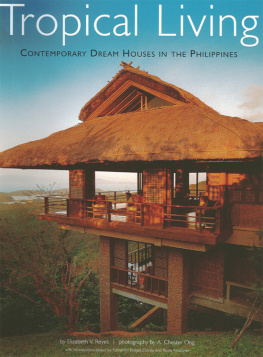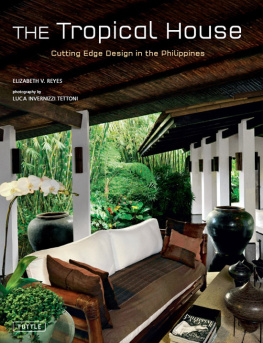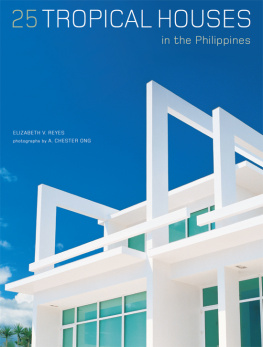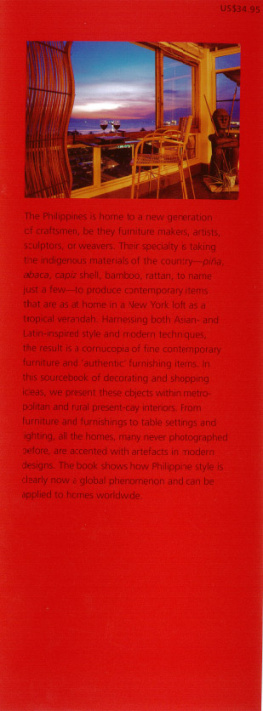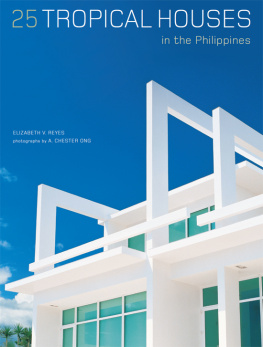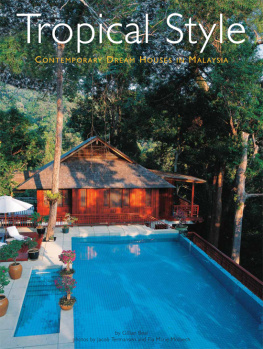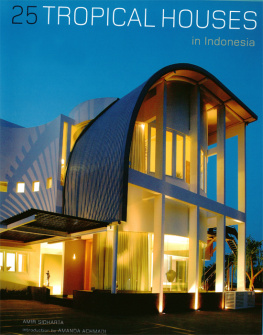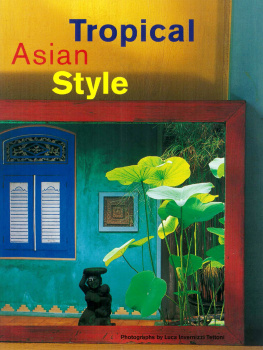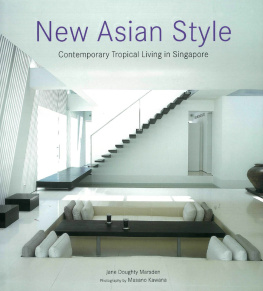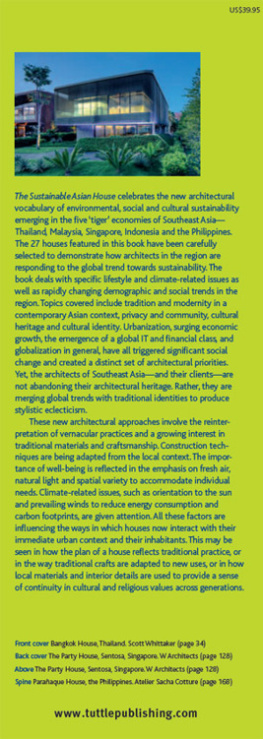acknowledgments
The author would like to thank the following for their help during the production of this book:
Coordination Assistance: Esperanza Fricke, Wendy Maramba, Mia Quimpo, Ami Rufino Starnegg. Photography Assistants: Rene Basilio, Felix Guinto. Photo favors (equipment and additional slides): Mitch Amurao, Tom Epperson, Miguel Fabie, Zac Moran & Melo Mondia, Lolito "Perry" Peregrino, Chopper Pilot, Lita Puyat, Denise Weldon. Accommodations: Mr. & Mrs. Carlos Cruz, Susanna B. Ortigas, Emma Matias & Martin Branner, DonJaime & Bea Zobel. Patrons, advisors, stylists: Florante Aguila, Ivy & Cynthia Almario, Jescel Canedo of Cebu Furniture Industries Foundation, Connie Castro, Peter Cho's Color Workshop, HongKong, Jojo Crisanto, Isabel Diaz, Doreen Fernandez, Yola Perez Johnson, Robert Lane, Jun Makapugay, Ino Manalo, Pilar B. Miranda, Linda Nakpil, Johnny Ramirez, Malou Antonio Veloso. Architect Interviewees: Pablo Antonio Jr, Ramon Antonio, Eduardo Calma, Lor Calma, Reimon Gutierrez, Andy Locsin, Francisco "Bobby" Manosa, Manny Minana, Ted Narciso, Conrad Onglao, Jose Pedro "Bong" Recio, Benji Reyes, Noel Saratan, Benny Velasco, Joey Yupangco. Additional Photography: Tom Epperson (pages 35, 202), Felix Guinto (pages 206, 214, 216, 217), Neil Lucenta & Claudine Sia (pages 114-118), Rene Araneta (pages 219, 220).
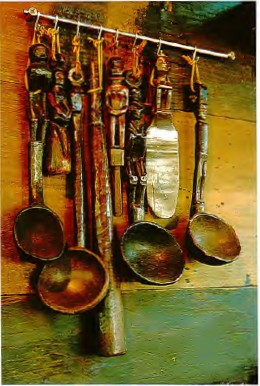

a different tropical style
The Republic of the Philippines shares with Indonesia the distinction of being the largest tropical archipelagos in the world. It has 7,100 islands, which range from small coral atolls to huge islands with deep forests and towering volcanoes. Wherever one travels in this beguiling land, there is always the promise of a breezy tropical scene; and there is always a new beach, with swaying palm trees and clear blue skies, where warm waves break and slide over the sands.
In tune with the country and climate is a relaxed, contemporary architectural style. Homes are tropical, exotic, romantic; there is a prodigious use of light and space; breezes flow through rooms, cooling and caressing occupants. A permanent feature is the lanai, a type of verandah that has wide eaves to shelter the interior from the sun and is open to the elements on at least three sides, thus ensuring the free flow of cooling breezes. In many cases it acts as an alternative to the more formal dining room. It is the place to lounge in, to relax in, to take in the scents of a tropical garden.
Filipino house design also reflects other features of the environment, such as the sea or the forests. For centuries, the capiz shell, a bivalve flatter than the oyster and more translucent when cleaned, has been used as the tiny panes of traditional wooden grid-windows. In modern design, capiz shell finds new applications, such as in lightboxes, picture frames or as tear drops in chandeliers. Furthermore, people who can afford it furnish their houses with increasingly rare local hardwoods which are superior in density and texture; one such example is the nana, a fragrant wood with an intense sienna color. In recent decades, other woods from the foothills are being used. Examples include coconut and bamboo trunks which, when split, flattened, diced, and laminated, are transformed into classy boards with unexpected textures.
There are many varieties of house design in the Philippines. Consider the lanai. One common interpretation used in beach houses is a simple structure of bent wooden columns that draw the thatch roof and split-bamboo ceiling close to the ground. Just as popular is the Mediterranean variation: eaves of curved red tiles, plain stone pillars, and tiled floors. Or the starkly simple: a cantilevered,concrete roof and highly polished marble floor that together extend outward to meet the sky and the lawn. There are also the personal, one-of-a-kind interpretations, such as the lanai that marries stone columns with ornate capitals and lace-like metal tracery on the roof edge.
Variety likewise characterizes Filipino furniture. Bauhaus inspires the locally made, severely simple furniture in. stainless steel, vinyl and glass; or, lately, comfortable sofas that combine wood and abaca, an extremely versatile hemp fiber. Yet other furniture styles include Mediterranean-inspired designs with a lavish use of scrolls and iron as the predominant material. Others draw on influences closer to home and simplify the horseshoe-shaped back-and arm-rests and curving back slats of Chinese chairs. There are, of course, other,designs that cannot be readily pigeon-holed. One example is designer Ernest Santiago's highly personal and comfortable long chair that evokes a river bank. Formed from multiple materialstwisted driftwood for the backrest, river stones for support, and flat serrated driftwood for the seat, it is a highly individualistic piece.


Unfortunately, Filipino design is little known abroad. Despite the extensive use of English in the country, the Philippines seems to have received less publicity than its neighbors. But in an era that increasingly appreciates cultural fusions between East and West, the Philippines is set to play a unique role as one of the original fusion cultures. Filipinos belong to the Austronesian-speaking peoples who populated an island realm that extended from Madagascar to Southeast Asia to Polynesia. Their indigenous houses were frame constructions with raised floors, built near or over water. Thatched roofs were steeply pitched to facilitate the release of hot tropical air and to drain off heavy rain. Wooden columns dug deep into the ground supported the trusses (these columns sway during the frequent earthquakes). Timber or bamboo walls were merely screens to keep out sun and wind. Furnishings were sparse: a low table, chests, and, in the absence of beds and chairs, woven straw mats.
In the late 16th century, Spanish colonial influence introduced stone and tile. However, earthquake conditions compelled builders to develop a "mixed style" (arquitectura mestiza), where solid wooden pillars of native tradition were implanted in curtain walls of stone or brick, thus defining room spaces. The upper-story walls of these new Filipino houses were made of wood and had large window openings with sliding panels of translucent capiz shell panes in checkerboard pattern. They recalled Japanese shoji screens, for along with the Chinese came Japanese settlers. The wood-and-stone Filipino house marries continents.
Other influences are evident. Seventeenth-century Manila was the anchor of the galleon trade, the first global commercial network to link three continents. Island-made galleons brought precious Oriental goods to Mexico, which then shipped them on to the Americas and Europe. In exchange, highly prized Mexican silver entered the Orient and enabled Filipinos to construct grand houses that bridged East and West. Tables, chairs, and commodes, inspired by European styles but in island hardwood, appeared. Decor was eclectic: saints carved from lndian ivories, Chinese lacquered screens, and Persian carpets, for example, may have been displayed in one room.
Modern building technology appeared in the twilight years of Spanish rule and became widespread after the U.S. took over in 1898. Public buildings, offices, and residences built in reinforced concrete in modernist styles, from Art Deco to the International, appeared. Although many buildings were destroyed during the Japanese Occupation of 1942-1945, after 1946 reconstruction following independence encouraged experimentation with modernist styles. Schools teaching contemporary design opened.

